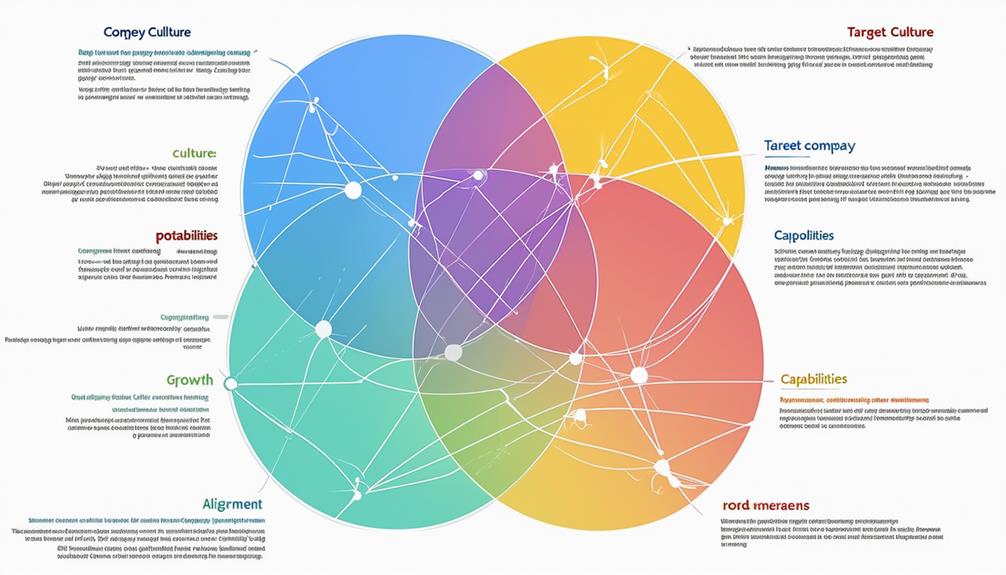Evaluating Synergies and Fit in M&A Target Identification

When identifying potential M&A targets, we conduct a thorough analysis of operational efficiencies, market positioning, and cultural alignment to evaluate synergies and fit. Our focus is on maximizing value creation by pinpointing synergistic benefits, enhancing revenue opportunities, and capturing cost savings. It is crucial to assess the strategic advantages of the targets under consideration and ensure a seamless integration process to drive successful outcomes.
By carefully examining these key areas, we can make well-informed strategic decisions that lead to successful M&A transactions. This methodical approach allows us to identify targets that not only align with our objectives but also offer the potential for long-term growth and sustainability. Our goal is to create value through strategic partnerships that leverage complementary strengths and resources for mutual benefit.
In today's competitive business environment, the process of identifying and screening M&A targets requires a comprehensive understanding of the market landscape, industry dynamics, and potential synergies. By focusing on operational efficiencies, market positioning, and cultural alignment, we can identify targets that present opportunities for value creation and growth.
Through a systematic evaluation of these factors, we can identify the most suitable targets for our strategic objectives and ensure a successful integration process.
Key Takeaways
When identifying potential targets for mergers and acquisitions, it is crucial to assess how well the operational processes, supply chains, and workflows of the target company align with those of the acquiring company. This evaluation helps in determining the operational efficiency and compatibility between the two entities, setting the foundation for a successful integration post-acquisition.
Another important aspect to consider is the market positioning, customer base, and growth opportunities of the target company. By analyzing these factors, companies can identify synergies in cross-selling and upselling opportunities, leading to increased revenue and market share post-acquisition.
Cultural alignment and shared values play a significant role in the success of a merger or acquisition. Evaluating the cultural fit between the two companies and devising integration strategies to address any differences can ensure a smooth transition and foster a collaborative work environment post-acquisition.
Furthermore, it is essential to identify potential cost-saving opportunities, revenue growth potential, and operational efficiency enhancements that can be achieved through the acquisition. By maximizing these value creation opportunities, companies can realize the full potential of the merger or acquisition.
Lastly, assessing the strategic advantages that the target company brings, such as complementary products, advanced technology, or strong customer relationships, can result in synergistic benefits that drive long-term success and growth for the acquiring company.
Assessing Operational Efficiencies
When considering potential M&A targets, it's crucial to thoroughly assess their operational efficiencies to determine how well they can be integrated into our existing operations. This requires a detailed analysis of processes, supply chains, and workflows to identify areas where cost savings and productivity improvements can be made.
By carefully evaluating the operational compatibility between the target company and our own, we can uncover synergies that will enhance overall performance post-acquisition. This involves understanding how the target's operations can complement our own capabilities and where redundancies can be eliminated.
A comprehensive review of operational efficiencies is vital for gauging the potential success of the merger and realizing our synergy objectives. Through a data-driven assessment of the target's processes, we can identify opportunities for optimization and gather valuable insights to guide our strategic decision-making.
Ultimately, examining operational efficiencies is a critical part of the process of identifying M&A targets. It enables us to make well-informed decisions that drive sustainable growth and give us a competitive edge in the market.
Evaluating Market Positioning
Analyzing the market positioning of a potential acquisition target plays a crucial role in evaluating strategic alignment and identifying revenue synergies. By delving into the target's competitive landscape, market share, and growth trajectory, we gain valuable insights into how it stands among its industry peers. This examination helps us understand:
- The target's customer base and product offerings in comparison to its competitors.
- Opportunities to leverage the acquirer's distribution channels and geographical footprint.
- The potential for cross-selling and upselling to the combined customer base.
- The alignment between the target's strengths and weaknesses and the acquirer's strategic goals.
Evaluating market positioning is essential for pinpointing synergies that can drive increased revenues post-acquisition. By aligning the target's market presence with the acquirer's capabilities, we can uncover new avenues for growth and enhance strategic integration. This thorough assessment is crucial for making well-informed decisions that maximize value creation throughout the M&A process.
Analyzing Cultural Alignment

When considering a merger or acquisition, it's essential to not only assess the target company's market position but also carefully evaluate the cultural alignment between the acquiring and target companies. Studies have highlighted that cultural mismatch is a significant factor leading to deal failures in M&A transactions. Therefore, having effective strategies for cultural integration is crucial for maximizing the success of an acquisition.
To gauge cultural alignment, various analysis tools such as surveys, interviews, and workshops can be utilized. These methods help in assessing shared values, beliefs, and behaviors while also identifying potential integration challenges arising from differences in leadership styles and organizational structures. By proactively addressing cultural fit, a strong foundation can be laid for a smooth post-merger integration process.
| Cultural Alignment Factors | Acquiring Company | Target Company | Level of Alignment |
|---|---|---|---|
| Communication Style | Formal, hierarchical | Casual, collaborative | Moderately Aligned |
| Leadership Approach | Authoritative, risk-averse | Empowering, innovative | Partially Aligned |
| Organizational Structure | Siloed, centralized | Flat, decentralized | Highly Aligned |
Understanding and managing cultural differences between the acquiring and target companies is crucial for the overall success of the merger or acquisition. By prioritizing cultural alignment and implementing effective integration strategies, organizations can navigate through the complexities of blending different organizational cultures and set the stage for a successful combined entity.
Maximizing Value Creation
To maximize value creation in mergers and acquisitions, it's crucial to pinpoint and leverage synergies between the acquiring and target companies. Through strategic fit assessments, we can ensure that the business objectives of both entities are in harmony, setting the stage for a successful combined organization.
Assessing synergy is key as it helps us quantify potential efficiencies, cost savings, and revenue growth opportunities post-merger. Evaluating cultural compatibility is equally important to facilitate seamless integration and reduce post-acquisition hurdles.
In the process of identifying suitable targets, we concentrate on selecting companies that offer the highest potential for value creation through synergistic alignments. This involves:
- Identifying complementary strengths and resources.
- Recognizing possibilities for achieving economies of scale and scope.
- Identifying potential revenue boosts through cross-selling.
- Determining operational streamlining opportunities through consolidated operations.
Identifying Synergistic Benefits

Let's dive into how recognizing synergistic benefits can add value during mergers and acquisitions.
Identifying potential cost savings and revenue growth opportunities plays a crucial role in assessing the compatibility of a target company.
Through a thorough analysis of these synergies, we can make well-informed decisions that optimize the overall value of the proposed deal.
Operational Cost Savings
Identifying operational cost savings synergies plays a crucial role in maximizing value creation and integration success during M&A deals. One effective strategy is to streamline processes to reduce redundancies and inefficiencies, leading to significant cost savings. This involves optimizing supply chain management and consolidating facilities to benefit from economies of scale and efficient resource utilization.
To evaluate operational synergies in M&A transactions, it's important to analyze potential reductions in salaries, wages, and facility expenses. By focusing on these areas, valuable cost-saving opportunities can be uncovered.
Here are some key strategies to consider:
- Enhance supply chain management to eliminate redundant logistics and distribution costs.
- Consolidate overlapping facilities and real estate to capitalize on economies of scale.
- Simplify administrative functions and shared services to decrease duplicative salaries and wages.
- Implement technology and automation to boost productivity and efficiency throughout the combined organization.
Effective identification and realization of these operational cost savings synergies are essential for the overall success of M&A deals.
Revenue Enhancement Opportunities
Unveiling revenue enhancement opportunities proves crucial in fully realizing the potential of M&A transactions, as synergies can significantly amplify sales, market share, and customer base. We pinpoint three primary areas where revenue synergies can be unlocked through mergers and acquisitions: complementary products, expanded distribution channels, and access to new markets.
Regarding complementary products, this involves merging products that cater to interconnected customer needs. This integration can lead to increased cross-selling opportunities and the provision of more comprehensive solutions, ultimately boosting revenue generation.
Expanding distribution channels entails leveraging the amalgamated sales and distribution networks to achieve broader market reach and enhance customer penetration. By tapping into each other's distribution channels, companies can optimize their sales strategies and capture a larger share of the market.
Accessing new markets involves venturing into untapped geographic or industry segments, thereby diversifying revenue streams and accelerating overall growth. This market expansion not only increases revenue potential but also positions the merged entity as a more competitive player in the industry.
Enhancing Revenue Opportunities
Utilizing revenue synergies can unlock significant value in M&A transactions by bolstering the top-line performance of the merged entity. Identifying and seizing revenue growth opportunities in target companies is crucial for driving lasting value creation.
Here are four primary methods to boost revenue opportunities through M&A:
- Pairing complementary products, patents, or geographic regions to broaden the customer base and promote cross-selling opportunities.
- Fine-tuning pricing strategies and sales approaches to tap into fresh revenue streams.
- Expanding into new markets and customer segments by harnessing the capabilities of the target firm.
- Enhancing market share and competitive standing through synergistic offerings and improved capabilities.
Thorough evaluation of these revenue synergies is vital for optimizing the benefits of M&A transactions. By prioritizing revenue enhancement, we can position the merged entity for sustained growth and a stronger market position.
Capturing Cost Savings

When assessing potential M&A targets, it's crucial to thoroughly analyze the opportunities for operational efficiency enhancements. By pinpointing synergies within the supply chain, we can simplify processes and lower operational costs, ultimately boosting the combined entity's financial performance.
Capturing these cost savings plays a pivotal role in a successful integration, enabling us to enhance competitiveness, increase shareholder value, and position the organization for sustained success.
Operational Efficiency Opportunities
When considering mergers and acquisitions, it's crucial to look for opportunities to improve efficiency in operations. This can have a significant impact on the success of a transaction by creating synergies that enhance overall value. It's important to assess ways to streamline supply chains, consolidate facilities, and optimize the workforce to drive cost savings and performance improvements.
Some key areas to focus on for operational efficiency include:
- Utilizing economies of scale to lower procurement expenses and increase buying power.
- Combining redundant business functions and administrative services to eliminate duplications.
- Implementing automation and advanced technologies to enhance productivity and streamline processes.
- Aligning the workforce of both companies and implementing industry best practices to improve overall business performance.
Supply Chain Integration Synergies
When considering mergers and acquisitions, it's crucial to explore the potential for supply chain integration synergies beyond just operational efficiencies. Aligning supply chain processes post-acquisition can lead to significant cost savings and increased value for the company.
By consolidating purchasing power, the merged entity can leverage better pricing and terms from suppliers. Centralizing distribution can help cut redundant warehouse and logistics costs through network optimization. Standardizing procurement practices eliminates duplicate systems and processes, streamlining operations further.
Capturing these synergies necessitates a deep understanding of the target's operational processes, technology systems, and distribution networks. Successful integration of supply chains can result in improved efficiencies, shorter lead times, and overall profitability. It's essential to carefully plan and execute the integration process to realize these benefits fully.
Evaluating Strategic Advantages
Evaluating strategic advantages plays a crucial role in identifying potential M&A targets that can enhance our competitive edge. It's important to analyze how the strengths of a potential target can address our weaknesses or capitalize on existing market opportunities. Understanding how the target's resources, capabilities, and market position can create synergies and add value post-acquisition is key.
When evaluating strategic fit, several key factors come into play:
- Market Positioning: Assess how the target's market presence and brand alignment can complement our own positioning in the market.
- Product/Service Offerings: Consider whether the target's products or services can enhance or diversify our current portfolio.
- Technological Capabilities: Evaluate how the target's technology can improve our capabilities or provide access to new markets.
- Customer Base Alignment: Analyze whether the target's customer relationships and distribution channels align with our target customer segments.
Ensuring Smooth Integration

Ensuring a seamless integration process is crucial for the success of mergers and acquisitions (M&A) deals. The alignment of cultures between the acquiring and target companies is vital, as it enables the smooth transition of the target's business environment into the acquirer's operations.
Moreover, operational congruence and transparent communication between the two organizations play a key role in integration success, allowing for the realization of synergies and the achievement of desired outcomes from the deal.
Assessing the geographical compatibility between the merging entities is another pivotal factor to consider, as it helps in determining the impact of location on integration strategies. By gaining a comprehensive understanding of the potential synergies and how they can be efficiently leveraged, we can enhance the integration results and ensure the long-term prosperity of the newly combined entity.
A successful M&A transaction hinges on a well-executed integration process. By giving due importance to cultural fit, operational alignment, and geographical considerations, we can navigate through the integration phase smoothly, unlocking the full value of the deal and paving the way for sustainable growth for the integrated business.
Frequently Asked Questions
How Do You Evaluate Synergies in M&A?
When evaluating synergies in M&A, it's essential to consider the potential financial benefits, operational enhancements, cultural fit, and strategic alignment. By thoroughly examining these critical aspects, we can effectively assess the value and compatibility of merger and acquisition opportunities.
Financial benefits play a significant role in evaluating synergies. These include cost savings, revenue enhancements, increased market share, and improved profitability. Understanding the potential financial gains can help determine the overall value and feasibility of a merger or acquisition.
Operational improvements are another key factor to consider. This involves analyzing how combining the resources, technology, and processes of the two companies can lead to efficiency gains, scale advantages, and better performance in the market.
Cultural compatibility is also crucial in evaluating synergies. Assessing whether the organizational cultures, values, and leadership styles align can impact the success of the merger or acquisition. A harmonious cultural fit can lead to better employee engagement, retention, and overall integration success.
Lastly, strategic alignment is essential for evaluating synergies in M&A. It involves assessing whether the combined entity's goals, objectives, and market positioning are in sync. A well-aligned strategy can drive growth, innovation, and competitive advantage in the marketplace.
How Is Synergy Evaluated?
We evaluate synergies by analyzing how the combined entity can drive operational efficiencies, achieve cost reductions, and expand revenue. It is crucial to ensure a strong cultural alignment to fully leverage the value created by the merger or acquisition. This cultural fit plays a significant role in determining the success of integrating two organizations.
How Do You Identify Synergies in M&A?
We identify synergies in M&A by analyzing potential for revenue growth, streamlining operations, exploring diversification opportunities, and expanding our customer base. By aligning these components, we aim to maximize value and implement innovative strategies in our transactions. This approach allows us to identify opportunities for sustainable growth and long-term success in the M&A process.
How Do You Evaluate M&A Targets?
When evaluating potential M&A targets, we focus on strategic alignment, market expansion opportunities, cost optimization potential, and cultural fit. These key factors are crucial in determining whether a target aligns with our innovative vision and long-term business objectives.
We conduct a thorough assessment of these factors to ensure that the target company is a good fit for our organization. By analyzing strategic alignment, we look at how well the target's business goals and objectives align with ours. This helps us determine if the acquisition will contribute to our overall growth and success in the market.
Market expansion opportunities are also a key consideration in our evaluation process. We assess the potential for the target company to help us enter new markets or expand our presence in existing ones. This analysis helps us determine the strategic value of the acquisition and its potential impact on our market position.
Cost optimization is another important factor we consider when evaluating M&A targets. We look for opportunities to streamline operations, eliminate redundancies, and improve efficiency through the acquisition. This helps us maximize the value of the deal and achieve cost savings that can benefit our bottom line.
Finally, cultural integration is a critical aspect of our assessment process. We evaluate the cultural fit between our organization and the target company to ensure a smooth integration and alignment of values, beliefs, and ways of working. This helps us minimize potential conflicts and ensure a successful transition post-acquisition.
Conclusion
When evaluating potential M&A targets, we meticulously analyze synergies, market positioning, and cultural alignment to uncover hidden value. Our focus is on identifying companies that offer not just financial gains but also strategic advantages that complement our existing operations. By honing in on operational efficiencies and revenue-generating opportunities, we aim to make these transactions not just successful but transformative for our competitive position.
Target identification is a critical stage in the M&A process, where thorough due diligence and strategic thinking can make or break a deal. It's not just about finding a company that looks good on paper; it's about finding one that fits seamlessly into our long-term vision and growth strategy. By leveraging our expertise in assessing synergies and market dynamics, we can pinpoint targets that have the potential to drive significant value creation for our organization.
Cultural fit is another key factor we consider when evaluating M&A targets. A harmonious cultural integration can pave the way for a smooth transition post-acquisition and enable us to fully realize the synergies and growth opportunities that initially attracted us to the target. By prioritizing cultural alignment alongside financial and strategic considerations, we increase the likelihood of a successful and value-enhancing M&A deal.
In the fast-paced world of M&A, the ability to identify and screen potential targets with precision and foresight is essential for sustainable growth and competitive advantage. By approaching target identification with a holistic mindset that encompasses synergies, market positioning, and cultural fit, we position ourselves to capitalize on opportunities that align seamlessly with our strategic objectives.